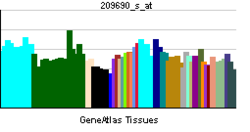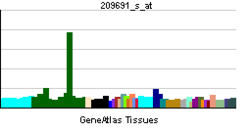- DOK4
-
Docking protein 4 Identifiers Symbols DOK4; FLJ10488 External IDs OMIM: 608333 MGI: 2148865 HomoloGene: 10009 GeneCards: DOK4 Gene Gene Ontology Molecular function • receptor signaling protein activity
• insulin receptor bindingBiological process • MAPKKK cascade
• transmembrane receptor protein tyrosine kinase signaling pathway
• nervous system developmentSources: Amigo / QuickGO RNA expression pattern 


More reference expression data Orthologs Species Human Mouse Entrez 55715 114255 Ensembl ENSG00000125170 ENSMUSG00000040631 UniProt Q8TEW6 Q99KE3 RefSeq (mRNA) NM_018110 NM_053246.3 RefSeq (protein) NP_060580 NP_444476.1 Location (UCSC) Chr 16:
57.51 – 57.52 MbChr 8:
97.39 – 97.4 MbPubMed search [1] [2] Docking protein 4 is a protein that in humans is encoded by the DOK4 gene.[1][2]
References
- ^ Loftus BJ, Kim UJ, Sneddon VP, Kalush F, Brandon R, Fuhrmann J, Mason T, Crosby ML, Barnstead M, Cronin L, Deslattes Mays A, Cao Y, Xu RX, Kang HL, Mitchell S, Eichler EE, Harris PC, Venter JC, Adams MD (Nov 1999). "Genome duplications and other features in 12 Mb of DNA sequence from human chromosome 16p and 16q". Genomics 60 (3): 295–308. doi:10.1006/geno.1999.5927. PMID 10493829.
- ^ "Entrez Gene: DOK4 docking protein 4". http://www.ncbi.nlm.nih.gov/sites/entrez?Db=gene&Cmd=ShowDetailView&TermToSearch=55715.
Further reading
- Al-Sarraf N, Reiff JN, Hinrichsen J, et al. (2007). "DOK4/IRS-5 expression is altered in clear cell renal cell carcinoma.". Int. J. Cancer 121 (5): 992–8. doi:10.1002/ijc.22776. PMID 17443497.
- Uchida M, Enomoto A, Fukuda T, et al. (2007). "Dok-4 regulates GDNF-dependent neurite outgrowth through downstream activation of Rap1 and mitogen-activated protein kinase.". J. Cell. Sci. 119 (Pt 15): 3067–77. doi:10.1242/jcs.03043. PMID 16820412.
- Gerhard DS, Wagner L, Feingold EA, et al. (2004). "The status, quality, and expansion of the NIH full-length cDNA project: the Mammalian Gene Collection (MGC).". Genome Res. 14 (10B): 2121–7. doi:10.1101/gr.2596504. PMC 528928. PMID 15489334. http://www.pubmedcentral.nih.gov/articlerender.fcgi?tool=pmcentrez&artid=528928.
- Ota T, Suzuki Y, Nishikawa T, et al. (2004). "Complete sequencing and characterization of 21,243 full-length human cDNAs.". Nat. Genet. 36 (1): 40–5. doi:10.1038/ng1285. PMID 14702039.
- Cai D, Dhe-Paganon S, Melendez PA, et al. (2003). "Two new substrates in insulin signaling, IRS5/DOK4 and IRS6/DOK5.". J. Biol. Chem. 278 (28): 25323–30. doi:10.1074/jbc.M212430200. PMID 12730241.
- Favre C, Gérard A, Clauzier E, et al. (2003). "DOK4 and DOK5: new Dok-related genes expressed in human T cells.". Genes Immun. 4 (1): 40–5. doi:10.1038/sj.gene.6363891. PMID 12595900.
- Strausberg RL, Feingold EA, Grouse LH, et al. (2003). "Generation and initial analysis of more than 15,000 full-length human and mouse cDNA sequences.". Proc. Natl. Acad. Sci. U.S.A. 99 (26): 16899–903. doi:10.1073/pnas.242603899. PMC 139241. PMID 12477932. http://www.pubmedcentral.nih.gov/articlerender.fcgi?tool=pmcentrez&artid=139241.
- Grimm J, Sachs M, Britsch S, et al. (2001). "Novel p62dok family members, dok-4 and dok-5, are substrates of the c-Ret receptor tyrosine kinase and mediate neuronal differentiation.". J. Cell Biol. 154 (2): 345–54. doi:10.1083/jcb.200102032. PMC 2150770. PMID 11470823. http://www.pubmedcentral.nih.gov/articlerender.fcgi?tool=pmcentrez&artid=2150770.
Categories:- Human proteins
- Chromosome 16 gene stubs
Wikimedia Foundation. 2010.
